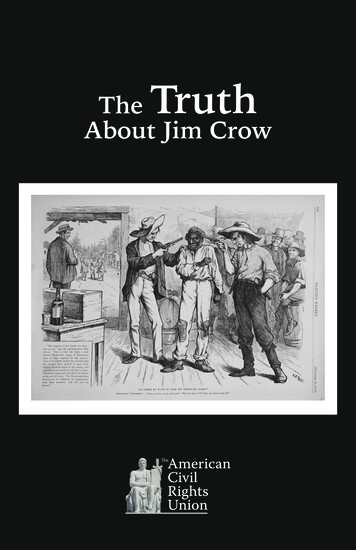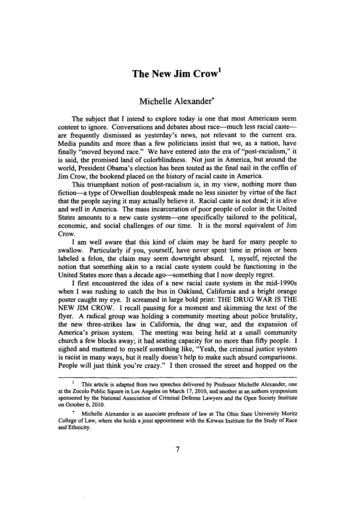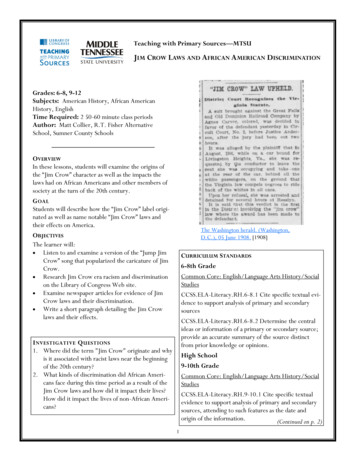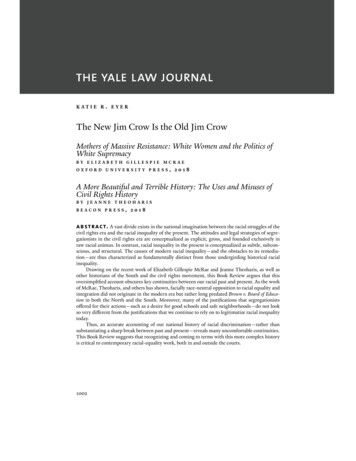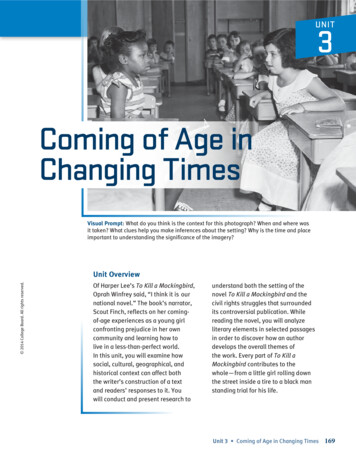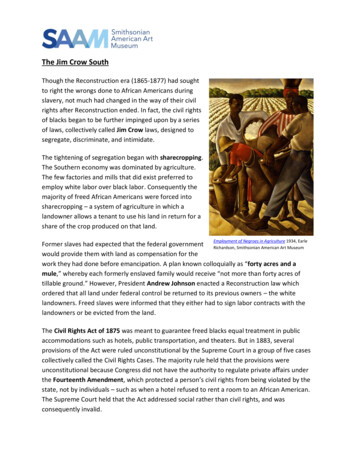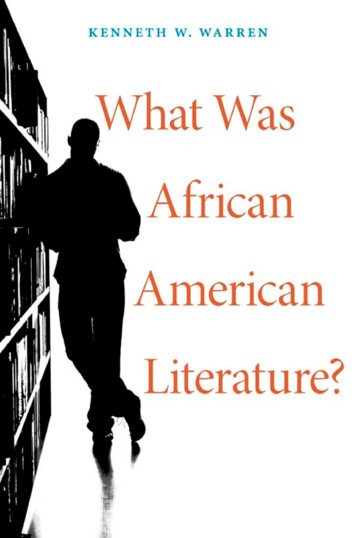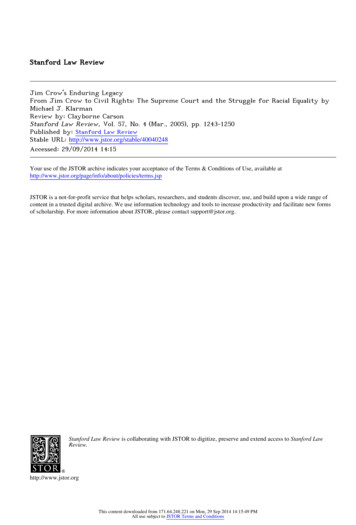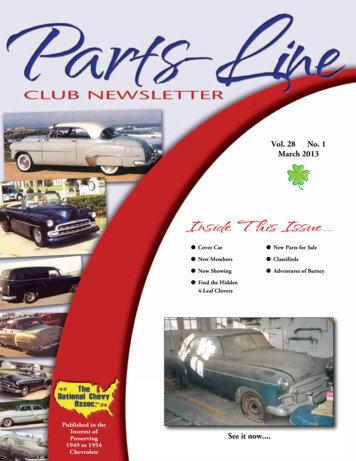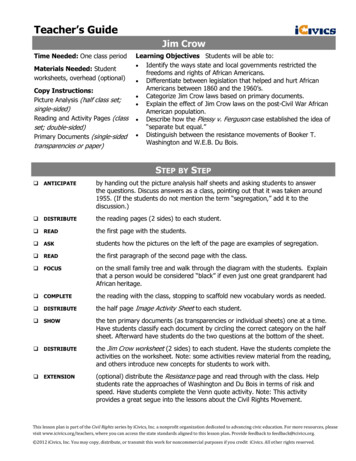
Transcription
Teacher’s GuideJim CrowTime Needed: One class periodMaterials Needed: Studentworksheets, overhead (optional)Copy Instructions:Picture Analysis (half class set;single-sided)Reading and Activity Pages (classset; double-sided)Primary Documents (single-sidedtransparencies or paper)Learning Objectives Students will be able to:Identify the ways state and local governments restricted thefreedoms and rights of African Americans.Differentiate between legislation that helped and hurt AfricanAmericans between 1860 and the 1960’s.Categorize Jim Crow laws based on primary documents.Explain the effect of Jim Crow laws on the post-Civil War AfricanAmerican population.Describe how the Plessy v. Ferguson case established the idea of“separate but equal.”Distinguish between the resistance movements of Booker T.Washington and W.E.B. Du Bois.STEP BY STEPANTICIPATEby handing out the picture analysis half sheets and asking students to answerthe questions. Discuss answers as a class, pointing out that it was taken around1955. (If the students do not mention the term “segregation,” add it to thediscussion.)DISTRIBUTEthe reading pages (2 sides) to each student.READthe first page with the students.ASKstudents how the pictures on the left of the page are examples of segregation.READthe first paragraph of the second page with the class.FOCUSon the small family tree and walk through the diagram with the students. Explainthat a person would be considered “black” if even just one great grandparent hadAfrican heritage.COMPLETEthe reading with the class, stopping to scaffold new vocabulary words as needed.DISTRIBUTEthe half page Image Activity Sheet to each student.SHOWthe ten primary documents (as transparencies or individual sheets) one at a time.Have students classify each document by circling the correct category on the halfsheet. Afterward have students do the two questions at the bottom of the sheet.DISTRIBUTEthe Jim Crow worksheet (2 sides) to each student. Have the students complete theactivities on the worksheet. Note: some activities review material from the reading,and others introduce new concepts for students to work with.EXTENSION(optional) distribute the Resistance page and read through with the class. Helpstudents rate the approaches of Washington and Du Bois in terms of risk andspeed. Have students complete the Venn quote activity. Note: This activityprovides a great segue into the lessons about the Civil Rights sbyiCivics,Inc.anonpro essonplan.Providefeedbacktofeedback@icivics.org. llotherrightsreserved.
Name:Name:4. List four words that come to mind when you see this picture:c) 19954. What words come to mind when you see this picture?b) 19553. Write a sentence about how this photograph makes you feel.a) 18352. When do you think this photograph was taken?1. List three ways these two water fountains are different:Look at this historical photograph and answer the questions thatfollow.Jim Crow3. Write a sentence about how this photograph makes you feel.2. When do you think this photograph was taken?a) 1835b) 1955c) 19951. List three ways these two water fountains are different:Look at this historical photograph and answer the questions thatfollow.Jim Crow
Jim CrowName:Slavery is over, now what?In the years right after the Civil War, freedmen (former slaves)were able to vote and participate in government, thanks to the13th, 14th and 15th Amendments and the Civil Rights Acts. Sadly,some people did not understand that freedmen deserved equalrights and opportunities. The federal government had beenprotecting these rights, but in 1877, Rutherford B. Hayes becamepresident and ended Reconstruction. All of a sudden, there was noone to enforce the new laws and amendments and no authority topunish those who treated blacks unfairly. From then on, peopleworked to undermine efforts at equality, and states passed lawsthat greatly restricted the rights and freedoms of blacks living inthe South (and the North!).Group of freedmen in Richmond, VA 1865Making AdjustmentsThe end of slavery meant major social changes for allbecause slavery had kept black and white societies apartfor so long. Once freed, former slaves acted quickly tocreate their own communities with new churches andschools. Some stayed in the South, while others migratedto the North hoping to find better living conditions andwork.Examples of segregationBy the 1870s, most southern states adopted laws knownas Black Codes, creating a legal form of segregation.Segregation is when people are separated by race. Thesecodes limited the rights and freedoms of black people.Northern states varied in the way they accepted the newarrivals, but segregation was common all over the nation.So, who is Jim Crow?Before the iPod, before television, movies and radio, peoplewent to the theater for entertainment. Daddy Rice, a whiteactor, would cover his face with charcoal and then sing anddance in a silly way. This character’s name was Jim Crow.Just like we compare people to characters on TV, peoplebegan to use Jim Crow as a way to describe black people. (Itwasn’t a compliment.) For example, there were ‘Jim Crow’cars on trains where all blacks were forced to sit, even if theybought a first-class ticket! As time went on, the term was alsoused to describe any racist law that restricted the rights andopportunities of black people.Early drawing of the JimCrow character and anentertainer performingin ‘black face’.You Say I Can’t Do What?!Jim Crow laws were found all over the South and even in many Northernstates. It would have been very difficult to walk around any large town orcity and not see a sign dividing whites and blacks. The segregation ofpublic accommodations was only one way that Jim Crow laws controlledpeople’s behavior. There were limits on whom people could marry, adopt,or where they could attend school. There was even one law limiting whocould cut your hair! The laws don’t make any sense today, but it was a factof life for the millions of people living in America between the 1860s andthe 1960s.Reading p.1
Jim CrowName:Who is Black?t-GeaGrAll of the Jim Crow laws were based on thedifference between whites and blacks. Butwhat does that mean? Most states decidedthat you were considered black if you hadonly one great grandparent who was black(1/8 African heritage). If there was doubt, aperson would have to prove that they couldgo back three generations without anyAfrican heritage.earpndradpansntGraresntrePasntYOUJim Crow LawsEducation: Public schools were provided forblack children, but they were not as nice asthe schools provided for white children. Mostlacked books, supplies and other resources.One law said that blacks and whites could notuse the same textbooks, and another requiredbus drivers to be the same race as thechildren they drove around!Public Accommodation:Accommodation means a placewhere people spend time. This canmean anything from a restaurant to aprison to a hotel. Many of the Jim Crowlaws were written to keep the racesseparate, and public spaces were themost visible area for interaction.Restaurants could not serve blacks andwhites in the same dining room.Circuses and theaters had to providetwo separate ticket booths, entrances,and seating areas. Missouri, Texas, andother states called for separate librariesfor blacks and whites. ‘White Only’signs were seen on bathroom doors,drinking fountains, public pools, waitingrooms and businesses all over theSouth and in some areas of the North.Marriage and Family: Miscegenation is a wordthat means the mixing of races. Both Northern andSouthern states had a variety of laws that bannedmarriages and relationships between blacks andwhites. There were also laws that either bannedinterracial (more than one race) adoptions orrequired the race of the baby and adopting parentsto be written on the legal documents.Voting Rights: We already knowthat freedmen were given the right tovote under the 15th Amendment in1870. Between 1871 and 1889,almost all Southern states passedlaws that restricted AfricanAmericans’ right to vote. In Georgiaand South Carolina black voting wascut in half between 1880 and 1888!Even when blacks did vote, many oftheir ballots were stolen or not evencounted. These restrictive lawscontinued into the 1960s untilPresident Lyndon Johnson signed theVoting Rights Act in 1965.Transportation: Blacks were required to sit in the back of public busesand train cars, or in a separate car altogether. The famous Supreme Courtcase Plessy v. Ferguson established that it was okay to create ‘separate butequal’ public settings. This 1896 case set the stage for numerous state andlocal laws requiring blacks and whites to stay segregated in society.Reading p.2
Jim CrowName:Your teacher will show you a document from the Jim Crow era. Which rights are restricted in eachdocument? Circle the correct category from the reading.Document 1Marriage and FamilyEducationPublic AccommodationTransportationVotingDocument 2Marriage and FamilyEducationPublic AccommodationTransportationVotingDocument 3Marriage and FamilyEducationPublic AccommodationTransportationVotingDocument 4Marriage and FamilyEducationPublic AccommodationTransportationVotingDocument 5Marriage and FamilyEducationPublic AccommodationTransportationVotingDocument 6Marriage and FamilyEducationPublic AccommodationTransportationVotingDocument 7Marriage and FamilyEducationPublic AccommodationTransportationVotingDocument 8Marriage and FamilyEducationPublic AccommodationTransportationVotingDocument 9Marriage and FamilyEducationPublic AccommodationTransportationVotingDocument 10Marriage and FamilyEducationPublic AccommodationTransportationVotingPlace a starnext to thedocument thatshocked youthe most.After looking at these examples, what do you think the purpose of these laws were?Image Activity– StudentJim CrowName:Your teacher will show you a document from the Jim Crow era. Which rights are restricted in eachdocument? Circle the correct category from the reading.Document 1Marriage and FamilyEducationPublic AccommodationTransportationVotingDocument 2Marriage and FamilyEducationPublic AccommodationTransportationVotingDocument 3Marriage and FamilyEducationPublic AccommodationTransportationVotingDocument 4Marriage and FamilyEducationPublic AccommodationTransportationVotingDocument 5Marriage and FamilyEducationPublic AccommodationTransportationVotingDocument 6Marriage and FamilyEducationPublic AccommodationTransportationVotingDocument 7Marriage and FamilyEducationPublic AccommodationTransportationVotingDocument 8Marriage and FamilyEducationPublic AccommodationTransportationVotingDocument 9Marriage and FamilyEducationPublic AccommodationTransportationVotingDocument 10Marriage and FamilyEducationPublic AccommodationTransportationVotingPlace a starnext to thedocument thatshocked youthe most.After looking at these examples, what do you think the purpose of these laws were?Image Activity– Student
umcotenenODLouisiana 1918umcoPoll Tax ReceiptowTtenDMississippi 1939Image Activity p.1
nteThre" no athletic team of any schoolshall engage in any athletic contest ofany nature within the state of Virginia withanother team on which persons of any otherrace are members."meucDoVirginia State Law 1960uroFnteumcoDAlabama 1931Image Activity p.2
veiF"White and colored persons shallnteumconot be taught in the same school, butDin separate schools under the same generalregulations as to management, usefulness andefficiency."Tennessee 1873muDocSixtenFlorida Bus 1950sImage Activity p.3
ntecumDoenveSInterracial adoptions are forbidden by law.Missouri State Law 1952uDocntemthEigBusinesses are allowed to choose theircustomers and have the right to refuse serviceto any person.Mississippi State Law 1956Image Activity p.4
eNintenmuDocDeclared that the legislature couldnever pass any law allowing "anymarriage between any white person and aNegro, or descendant of a Negro."Alabama Constitution 1901muDocTentenTexas Bus Station 1952Image Activity p.5
Jim CrowName:Vocabulary. Use the words in the bank to complete these sentences.1. Hotels, restaurants, shops, public restrooms and drinking fountains are all examplesof .2. describes the mixing of different races through marriageinterracialand family, and was illegal in many states.Black Codes3. State and local governments passed laws intended to , orsegregationweaken, the new rights blacks had gained in the South.Jim Crowmiscegenationpublicaccommodationundermine4. Adoptions were considered if the parents were of adifferent race than the child.5. Keeping groups of people separate is called .6. was originally a theater character, but became aterm that described things related to African Americans.7. After the Civil War, many states passed laws, or , thataffected the rights and freedoms of the freed slaves.Help or Hurt? Read a description of each lawor amendment and decide if it helped AfricanAmericans or hurt them.tHurSeparate but Equal: SupremeCourt decision saying it’s ok tokeep the races separate if thingsare equaltHurBlack Codes: laws passed in theSouth to limit rights & segregateAfrican AmericansedHelpedHelpOut of Order! Read the facts about thecase of Plessy v. Ferguson and put theremaining facts in the correct order.Louisiana passes the Separate Car Act that makesrailroad companies provide separate (but equal) carsfor black and white passengers in 1890. A group ofblack citizens joined with the East Louisiana Rail RoadCompany to fight the Act. (The citizens wanted rightsand the RR company wanted to save money by usingfewer cars.) Homer Plessy was chosen to break thelaw so it could be challenged in court.Can you put the rest of the story in the correct order?Plessy appealed the decision and lost again, buttook the case to the Supreme Court in 1896.edHelp13th Amendment: abolishedslavery in the Unites StatestHuredHelptHur14th Amendment: all people bornin US are now citizens, thegovernment must give all peopleequal protection of the law, andapply the laws in the same wayto all peopleHomer Plessy bought a first class train ticket andsat down in the ‘whites only’ section of the train.The Supreme Court upheld the previousdecisions and said that racial segregation wasconstitutional if accommodations were equal.This led to more and more legal segregation allover the US.Plessy was arrested for riding in a ‘whites only’railroad car, because he was 1/8th black.Plessy argued that the Act violated his 13th &14th Amendment rights, but he lost in the localcourt.Worksheet p.1
Jim CrowName:Barriers to Voting What kinds of laws did Southern states use to keep blacks from voting?Connect the laws to the descriptions to find out!Citizens had to pay a fee to the poll worker before they could vote.White PrimaryGrandfather ClausePoll TestsPoll TaxesIntimidation & ViolenceOnly white people could vote in the primary party elections, so theydecided who would be running in the regular election.In order to register or get to the polls, blacks faced threats, beatingsand false arrests.Citizens had to pass reading and logic questions that the pool worker‘graded’. If you were white, you usually passed.Only those who had grandfathers who could vote before the Civil Warcould vote in elections. (Few if any blacks voted before the Civil War!)Cartoon Time! Two groups are shown in this cartoon. Answer the questions for each group.Section A1. What two groups do these people represent?A2. What emotions are they showing?3. Complete the three statements you see.The Union as it .This is a man’s government.The cause.B4. Do these men look a) powerful or b) weak?Section B5. Who do these people represent?6. What emotion are they showing?7. Find each image and label with the correctletter.a) Man hanging in tree b) Book & ABC’sc) Burning school house d) Pool of blood“Worse Than Slavery” was in the pages of Harper’s Weekly on October 24,1874. Thomas Nast was the cartoonist.What did Thomas Nast think about Jim Crow laws andhow blacks were treated after the Civil War?The lives of blacks a) have or b) have not improvedsince slavery ended.Provide two pieces of evidence from the cartoon.Evidence 1Evidence 28. What do these symbols represent?Worksheet p.2
Jim Crow“Worse Than Slavery” was in the pages of Harper’s Weekly on October 24, 1874.Thomas Nast was the cartoonist.Overhead for Worksheet
Jim CrowName:“Strike for your lives and liberties Let your motto be Resistance!Resistance! Resistance! What kind of resistance you make you must decideby the circumstances that surround you.”Former slave and abolitionist, Henry Highland Garnet, speaking to a group of northern freeblacks in 1843.Resistance to Jim Crow took many forms throughout the nation and over the years. Itincluded individual acts of defiance, organized legal challenges, and efforts at gettingmore education and employment opportunities for African Americans. People agreed on the fact that Jim Crowlaws were unfair and cruel, but they disagreed about how to best deal with the problem. Booker T.Washington and W.E.B. Du Bois are the leading examples of the two main approaches.W.E.B. Du Bois (1868-1963)Booker T. Washington (1856-1915)Washington was born on a plantation in1856. After emancipation, he and his familymoved to West Virginia where he worked andwent to school. His interest in education ledhim to head the Tuskegee Institute, where AfricanAmericans were taught to be teachers, farmers, andactive citizens.Washington became one of the most influential blackmen of his time. He called for African Americans to focuson hard work and create community support groups. Hewanted to strengthen the race from the inside beforefighting against segregation and Jim Crow. He believedeconomic security would lead to greater civil rights andbetter race relations.Du Bois was born after emancipation inMassachusetts. He earned his Ph.D. atHarvard University. Du Bois studied andresearched the lives of African Americans.The more he learned, the more he believed that the onlyway black Americans could gain civil rights was throughprotest and activism. He disagreed with Washington’sdesire to earn respect of whites first and hope that rightswould follow.W.E.B. Du Bois was involved in the creation of the NAACP(National Association for the Advancement of ColoredPeople). This organization challenged segregation,lynching, and unfair voting laws in court.How risky was Washington’s approach?How risky was Du Bois’ approach?MoreLessMoreHow long might this approach take?Long TimeHow long might this approach take?Short TimeLong TimeShort TimeWho Might Have Said This? Place the letter of thestatement in the correct area of the quote bubbles.BothBooker T. WashingtonLessW.E.B. Du BoisA. I created the NAACP to fight discriminatory lawsB. I founded Tuskegee Institute to train blacks in agricultureand education.C. African Americans are not treated equally.D. Now is the accepted time, not tomorrow.E. It is at the bottom of life that we must begin, not at thetop.F. I worked to advance African Americans’ rights.G. Protesting is necessary to fight for constitutional rights.H. We can earn constitutional rights through economicsecurity and respectability.Extension p.1
Jim Crow**TEACHER GUIDE**Your teacher will show you a document from the Jim Crow era. Which rights are restricted in eachdocument? Circle the correct category from the reading.Document 1Marriage and FamilyEducationPublic AccommodationDocument 2Marriage and FamilyEducationPublic Accommodation TransportationDocument 3Marriage and FamilyEducationDocument 4Marriage and FamilyEducationDocument 5Marriage and FamilyEducationDocument 6Marriage and FamilyEducationPublic AccommodationTransportation VotingDocument 7Marriage and Family EducationPublic AccommodationTransportationVotingDocument 8Marriage and FamilyPublic Accommodation TransportationVotingDocument 9Marriage and Family EducationDocument 10Marriage and FamilyPlace a starnext to thedocument thatshocked youthe most.EducationEducationPublic ionVotingPublic Accommodation TransportationVotingPublic AccommodationPublic AccommodationTransportationTransportationPublic Accommodation TransportationVotingVotingVotingAfter looking at these examples, what do you think the purpose of these laws were?Answers will vary- these laws want to maintain the segregation of theracesImage Activity– StudentJim CrowName:Your teacher will show you a document from the Jim Crow era. Which rights are restricted in eachdocument? Circle the correct category from the reading.Document 1Marriage and FamilyEducationPublic AccommodationTransportationVotingDocument 2Marriage and FamilyEducationPublic AccommodationTransportationVotingDocument 3Marriage and FamilyEducationPublic AccommodationTransportationVotingDocument 4Marriage and FamilyEducationPublic AccommodationTransportationVotingDocument 5Marriage and FamilyEducationPublic AccommodationTransportationVotingDocument 6Marriage and FamilyEducationPublic AccommodationTransportationVotingDocument 7Marriage and FamilyEducationPublic AccommodationTransportationVotingDocument 8Marriage and FamilyEducationPublic AccommodationTransportationVotingDocument 9Marriage and FamilyEducationPublic AccommodationTransportationVotingDocument 10Marriage and FamilyEducationPublic AccommodationTransportationVotingPlace a starnext to thedocument thatshocked youthe most.After looking at these examples, what do you think the purpose of these laws were?Image Activity– Student
Jim Crow**TEACHER GUIDE**Vocabulary. Use the words in the bank to complete these sentences.1. Hotels, restaurants, shops, public restrooms and drinking fountains are all examplesof public accommodation .2. Miscegenation describes the mixing of different races through marriage andinterracialfamily, and was illegal in many states.Black Codes3. State and local governments passed laws intended to undermine , or weaken,segregationthe new rights blacks had gained in the South.Jim Crow4. Adoptions were considered interracial if the parents were of a different racemiscegenationpublicaccommodationunderminethan the child.5. Keeping groups of people separate is called segregation .6. Jim Crow was originally a theater character, but became a term thatdescribed things related to African Americans.7. After the Civil War, many states passed laws, or Black Codes , that affected therights and freedoms of the freed slaves.Help or Hurt? Read a description of each lawor amendment and decide if it helped AfricanAmericans or hurt them.tHurSeparate but Equal: SupremeCourt decision saying it’s ok tokeep the races separate if thingsare equaltHurBlack Codes: laws passed in theSouth to limit rights & segregateAfrican AmericansedHelpedHelpOut of Order! Read the facts about thecase of Plessy v. Ferguson and put theremaining facts in the correct order.Louisiana passes the Separate Car Act that makesrailroad companies provide separate (but equal) carsfor black and white passengers in 1890. A group ofblack citizens joined with the East Louisiana Rail RoadCompany to fight the Act. (The citizens wanted rightsand the RR company wanted to save money by usingfewer cars.) Homer Plessy was chosen to break thelaw so it could be challenged in court.Can you put the rest of the story in the correct order?4 Plessy appealed the decision and lost again, buttook the case to the Supreme Court in 1896.edHelp13th Amendment: abolishedslavery in the Unites StatestHuredHelptHur14th Amendment: all people bornin US are now citizens, thegovernment must give all peopleequal protection of the law, andapply the laws in the same wayto all people1 Homer Plessy bought a first class train ticket andsat down in the ‘whites only’ section of the train.5 The Supreme Court upheld the previousdecisions and said that racial segregation wasconstitutional if accommodations were equal.This led to more and more legal segregation allover the US.2 Plessy was arrested for riding in a ‘whites only’railroad car, because he was 1/8th black.3 Plessy argued that the Act violated his 13th &14th Amendment rights, but he lost in the localcourt.Worksheet p.1
Jim Crow**TEACHER GUIDE**Barriers to Voting What kinds of laws did Southern states use to keep blacks from voting?Connect the laws to the descriptions to find out!Citizens had to pay a fee to the poll worker before they could vote.White PrimaryGrandfather ClausePoll TestsPoll TaxesIntimidation & ViolenceOnly white people could vote in the primary party elections, so theydecided who would be running in the regular election.In order to register or get to the polls, blacks faced threats, beatingsand false arrests.Citizens had to pass reading and logic questions that the pool worker‘graded’. If you were white, you usually passed.Only those who had grandfathers who could vote before the Civil Warcould vote in elections. (Few if any blacks voted before the Civil War!)Cartoon Time! Two groups are shown in this cartoon. Answer the questions for each group.Section A1. What two groups do these people represent?AThe White League and the KKK2. What emotions are they showing?Answers will vary– happy, proud,accomplished, hidden (hat and hood)a3. Complete the three statements you see.The Union as it was.This is a white man’s government.The lost cause.Bc4. Do these men look a) powerful or b) weak?Section B5. Who do these people represent?dbFreed slaves, African Americans in the South6. What emotion are they showing?“Worse Than Slavery” was in the pages of Harper’s Weekly on October 24,1874. Thomas Nast was the cartoonist.Answers will vary– fear7. Find each image and label with the correctletter.a) Man hanging in tree b) Book & ABC’sc) Burning school house d) Pool of blood8. What do these symbols represent?Answers will vary– the dangers of AfricanAmericans under Jim Crow laws, the African American situation, etc.What did Thomas Nast think about Jim Crow laws and howblacks were treated after the Civil War?The lives of blacks a) have or b) have not improved sinceslavery ended.Provide two pieces of evidence from the cartoon.Evidence 1Examples:Title of the cartoon is“WORSE Than Slavery.”Evidence 2The people are coweringand afraid and there aresigns of violence.Worksheet p.2
Jim Crow**TEACHER GUIDE**“Strike for your lives and liberties Let your motto be Resistance!Resistance! Resistance! What kind of resistance you make you must decideby the circumstances that surround you.”Former slave and abolitionist, Henry Highland Garnet, speaking to a group of northern freeblacks in 1843.Resistance to Jim Crow took many forms throughout the nation and over the years.It included individual acts of defiance, organized legal challenges, and efforts atgetting more education and employment opportunities for African Americans. People agreed on the factthat Jim Crow laws were unfair and cruel, but they disagreed about how to best deal with the problem.Booker T. Washington and W.E.B. Du Bois are the leading examples of the two main approaches.W.E.B. Du Bois (1868-1963)Booker T. Washington (1856-1915)Washington was born on a plantation in1856. After emancipation, he and his familymoved to West Virginia where he worked andwent to school. His interest in education ledhim to head the Tuskegee Institute, where AfricanAmericans were taught to be teachers, farmers, andactive citizens.Washington became one of the most influential blackmen of his time. He called for African Americans to focuson hard work and create community support groups. Hewanted to strengthen the race from the inside beforefighting against segregation and Jim Crow. He believedeconomic security would lead to greater civil rights andbetter race relations.How risky was Washington’s approach?Du Bois was born after emancipation inMassachusetts. He earned his Ph.D. atHarvard University. Du Bois studied andresearched the lives of African Americans.The more he learned, the more he believed that the onlyway black Americans could gain civil rights was throughprotest and activism. He disagreed with Washington’sdesire to earn respect of whites first and hope that rightswould follow.W.E.B. Du Bois was involved in the creation of the NAACP(National Association for the Advancement of ColoredPeople). This organization challenged segregation,lynching, and unfair voting laws in court.How risky was Du Bois’ approach?MoreLessMoreHow long might this approach take?LessHow long might this approach take?Long TimeShort TimeLong TimeShort TimeThis is up for class discussion. The sugges ons for line placements are just a starter.Who Might Have Said This? Place the letter of thestatement in the correct area of the quote bubbles.BothDBHCEAFGBooker T. WashingtonW.E.B. Du BoisA. I created the NAACP to fight discriminatory lawsB. I founded Tuskegee Institute to train blacks in agricultureand education.C. African Americans are not treated equally.D. Now is the accepted time, not tomorrow.E. It is at the bottom of life that we must begin, not at thetop.F. I worked to advance African Americans’ rights.G. Protesting is necessary to fight for constitutional rights.H. We can earn constitutional rights through economicsecurity and respectability.
Jim Crow Learning Objectives Students will be able to: x Identify the ways state and local governments restricted the freedoms and rights of African Americans. x Differentiate between legislation that helped and hurt African Americansbetween1860andthe1960’s. x Categorize Jim Crow laws based on primary documents. x Explain t
